GROWING AND PREPARING WATERMELON RADISH
Watermelon radish is an heirloom variety of the Chinese daikon radish. It gets its name from the bright pink and green coloring. As for the taste – it’s a mild radish-y flavor! It doesn’t taste like watermelon! LOL!
![]()
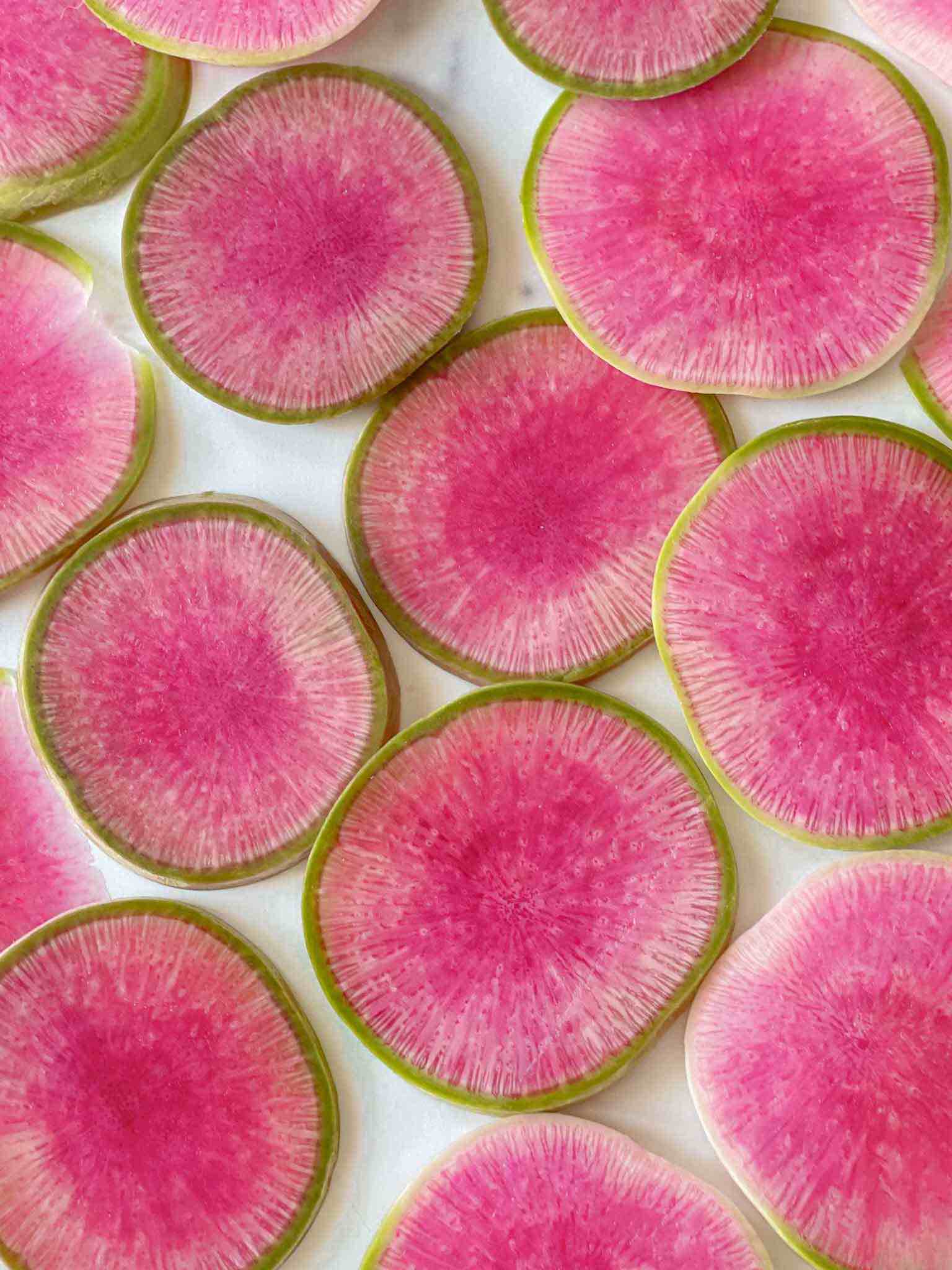
I’m obsessed! Actually, I’m obsessed with all radishes these days, but watermelon radish is my favorite! Watermelon radish is a visually stunning and versatile vegetable that deserves a place in your garden and on your plate. Its vibrant pink center, mild peppery taste, and nutritional benefits make it a delightful addition to salads, pickles, roasted dishes, and more. Watermelon radish plays center stage in my Spring garden. You can see my Spring garden layout, seed choices, and each planting here in the Garden to Table section.
Watermelon radish, with its stunning appearance and mild peppery flavor, is a unique and captivating vegetable that can elevate your gardening and culinary experiences. With its vibrant pink center and green outer skin, watermelon radish adds a pop of color to any dish. In this blog post, we will delve into the fascinating world of watermelon radish, exploring its origins, nutritional benefits, how to grow it in your garden, and exciting ways to incorporate it into your meals.
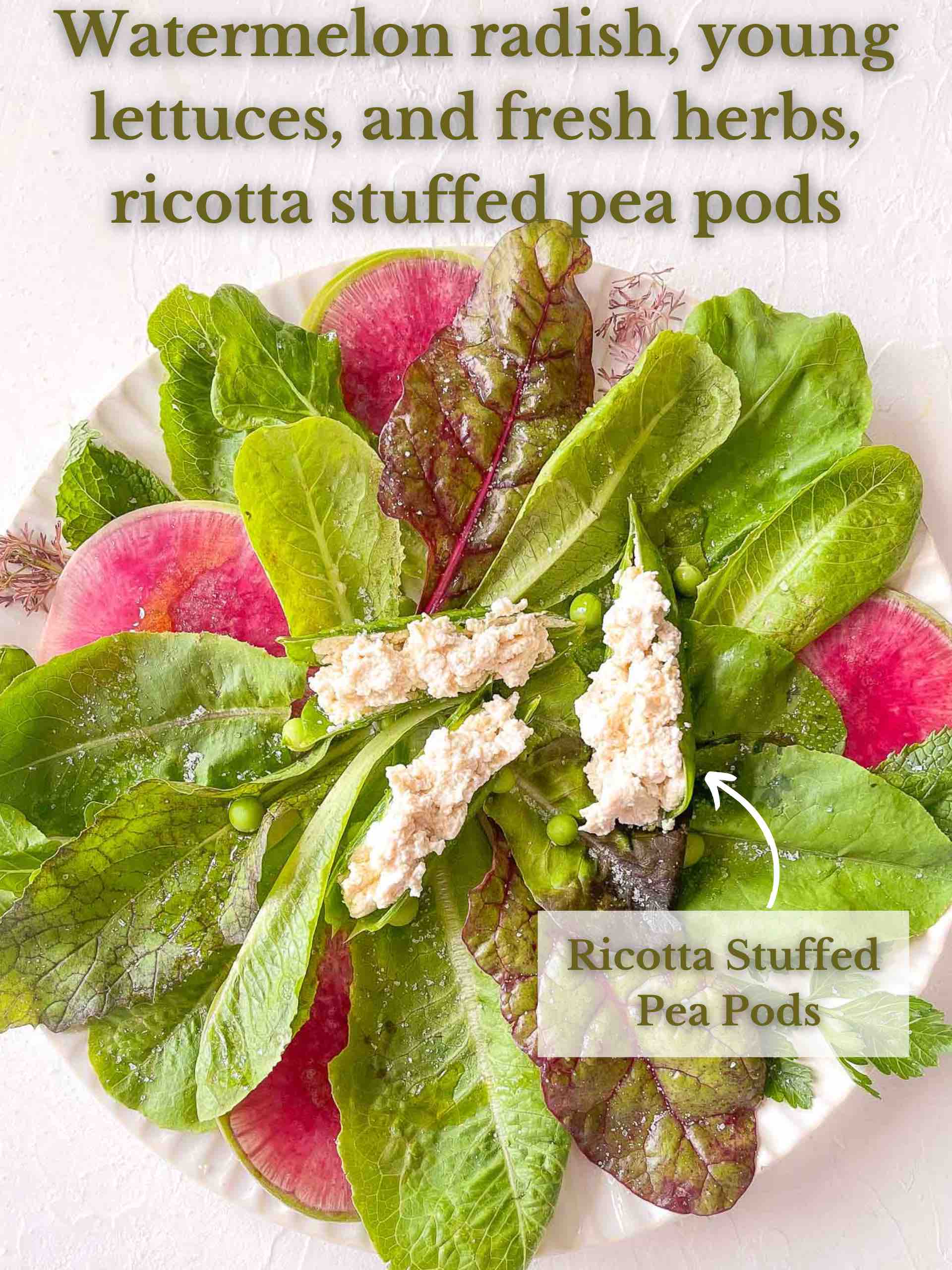
Reasons You’ll Love Watermelon Radish
Here are a few – all very beautiful and visually appealing!
-
- Vibrant colors – Watermelon radishes are visually stunning with their vibrant pink, magenta, and green hues. They add a pop of color to any dish, making them a beautiful addition to salads, garnishes, and vegetable platters.
- Unique appearance – The watermelon radish’s unique appearance, with its white-green exterior and contrasting pink or red interior, makes it an intriguing and conversation-starting vegetable. It stands out among other radish varieties and adds visual interest to your meals.
- Mild and sweet flavor – Watermelon radishes have a mild and slightly sweet flavor compared to other radish varieties. The taste is often described as refreshing, crisp, and slightly peppery. It provides a pleasant and delicate flavor to salads, sandwiches, and other dishes.
- Versatile culinary uses – Watermelon radishes are incredibly versatile in the kitchen. You can enjoy them raw in salads for their crunchy texture and vibrant color. They can be sliced, diced, or grated to add a unique twist to slaws, stir-fries, and grain bowls. They can also be pickled or roasted to enhance their natural sweetness and bring out their earthy flavors.
- Nutritional benefits – Like other radish varieties, watermelon radishes are packed with nutrients. They are a good source of vitamin C, potassium, and fiber. Additionally, they are low in calories, making them a healthy choice for adding flavor and nutrition to your meals.
- Easy to grow – Watermelon radishes are relatively easy to grow, even for beginners. They have a relatively short growing period and can be grown in both spring and fall seasons. With proper care and maintenance, you can enjoy a bountiful harvest of these delightful radishes.
- Unique culinary presentation – Watermelon radishes can be used as a creative ingredient for stunning culinary presentations. Their vibrant colors and unique appearance make them a favorite among chefs and food enthusiasts for creating visually appealing dishes and elevating the overall dining experience.
With their striking colors, mild flavor, versatility in the kitchen, nutritional benefits, and ease of cultivation, watermelon radishes offer a delightful culinary experience. Whether you’re a home cook or a professional chef, these radishes can add a touch of beauty and flavor to your dishes, making them a true culinary delight.
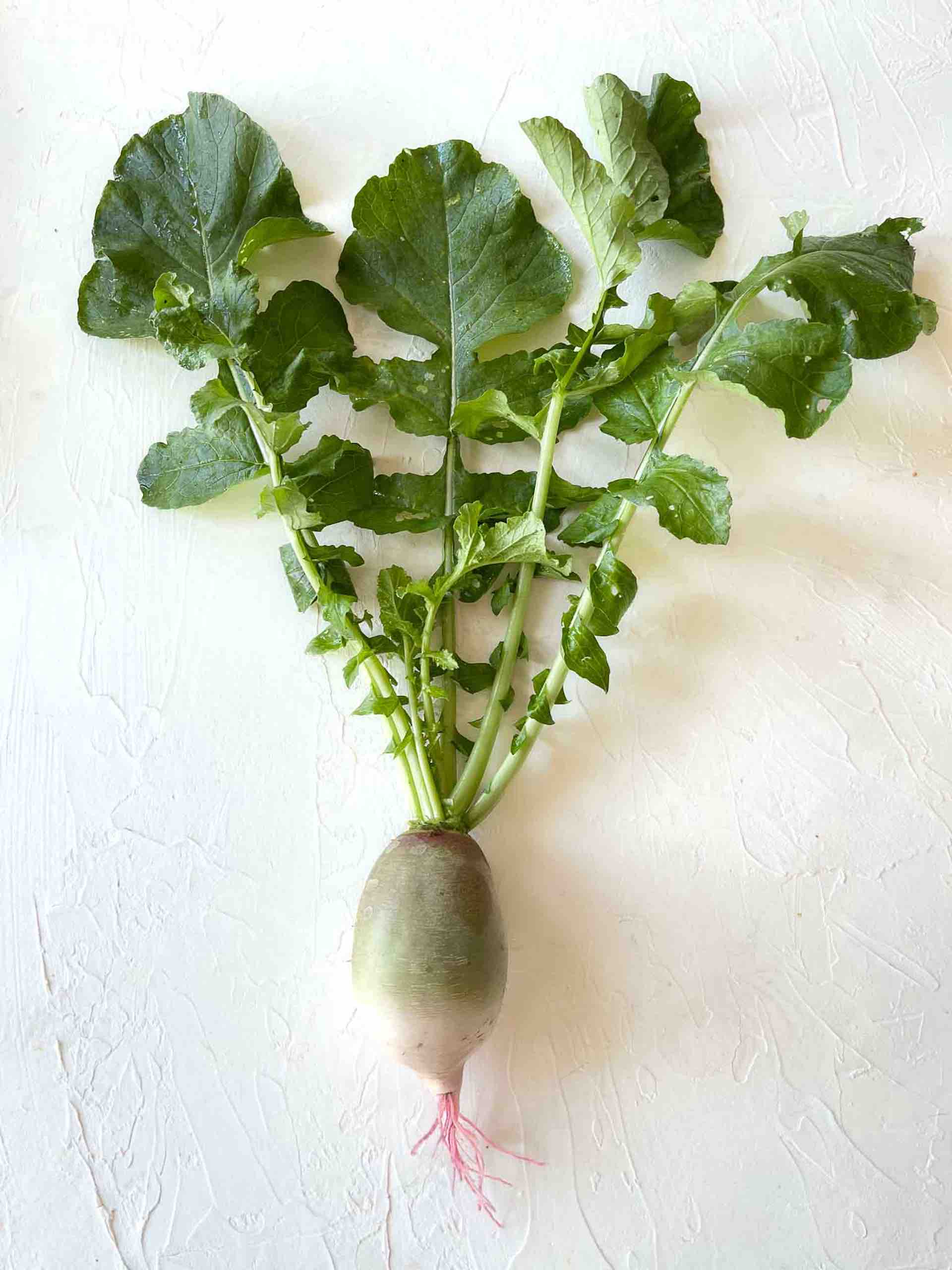
Varieties of Watermelon Radish
Here are a few – all very beautiful and visually appealing!
-
- Watermelon Radish (Raphanus sativus) – This is the most common variety and is known for its white-green outer skin and vibrant pink or red flesh. It typically has a round shape and reaches a diameter of 2-4 inches (5-10 cm). The flesh is sweet and slightly peppery.
- Red Meat Radish – Also referred to as “Red Meat” or “Beauty Heart,” this variety features a white to pale green exterior and an intensely deep pink or red center. The flavor is mild and slightly sweet. The Red Meat radish can grow larger than the standard watermelon radish, with some reaching 5-6 inches (12-15 cm) in diameter.
- China Rose Radish – This variety has a beautiful rose-pink interior that contrasts with its pale green skin. The China Rose radish is slightly spicier compared to other watermelon radish varieties, adding a zesty kick to salads and other dishes.
- Misato Rose Radish – Originating from Japan, the Misato Rose radish has a stunning magenta interior with a greenish-gray outer skin. It has a mild flavor with a hint of sweetness and a crisp texture. This variety is often used in salads, pickling, and garnishing.
- Black Spanish Radish – Although not technically a watermelon radish, the Black Spanish radish is worth mentioning due to its similar appearance. It has a black or dark brown skin and a white or off-white interior. The strong and spicy flavor makes it a popular choice for pickling and cooking.
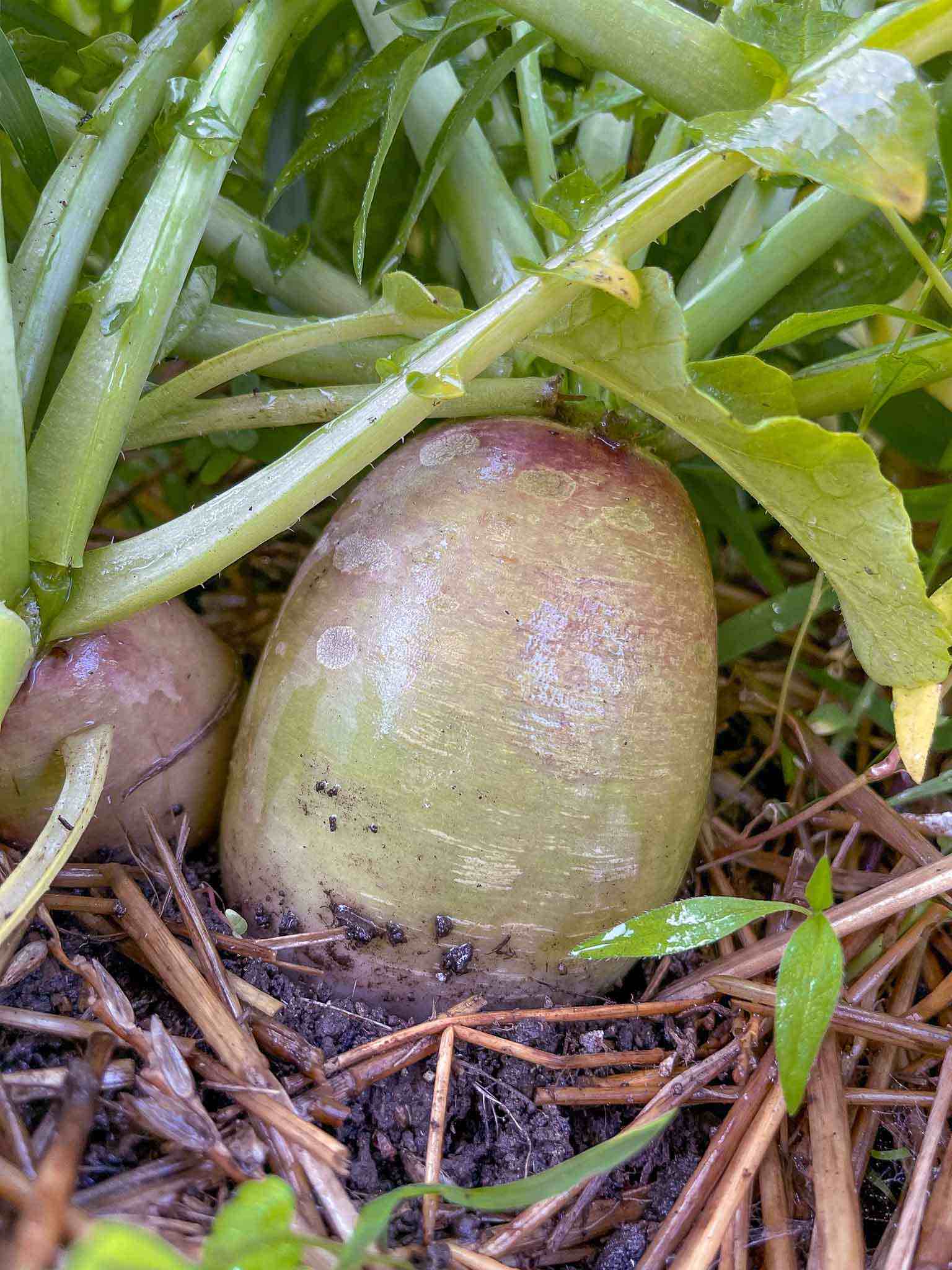
How to Grow Watermelon Radish
Watermelon radish is fairly easy to grow and is ready in 55-60 days!
-
- Choose the right season – Plant watermelon radish in early spring or late summer/early fall, avoiding hot summer months.
- Select a suitable planting location – Find a spot with full sun (6-8 hours per day) and well-draining soil (pH 6.0-7.0) rich in organic matter.
- Prepare the soil – Remove weeds, loosen the soil, and incorporate organic matter like compost or well-rotted manure.
- Sow the seeds – Plant watermelon radish seeds directly into the soil, about half an inch deep and 4-6 inches apart. Water gently after planting.
- Watering and care – Keep the soil evenly moist, especially during dry periods. Avoid overwatering and use mulch to conserve moisture and suppress weeds.
- Thinning and spacing – Once the seedlings emerge, thin them out to the recommended spacing for proper growth and development.
- Fertilizing – Apply balanced organic fertilizer or compost during planting and side-dress with additional fertilizer during the growing season.
- Pest and disease management – Monitor for common pests like aphids, flea beetles, or cabbage worms, and use organic pest control methods if needed.
- Harvesting – Watermelon radishes are ready to harvest in about 55-60 days. Gently loosen the soil and pull them out, leaving about an inch of stem attached.

Following these steps, you can successfully grow your watermelon radishes and enjoy their unique beauty and delicious taste in your culinary creations. Happy gardening!

Watermelon Radish Pests and Bugs
Watermelon radish can be susceptible to certain pests and bugs.
-
- Aphids – These small, soft-bodied insects feed on the sap of plants and can cause stunted growth and distorted leaves. They are often found on the undersides of leaves. To control aphids, you can spray the plants with a strong stream of water or use insecticidal soap or neem oil.
- Flea Beetles – Flea beetles are tiny insects that can chew small holes in the leaves of watermelon radish plants. They are known for their jumping behavior when disturbed. To manage flea beetles, you can use floating row covers to prevent their access to the plants or apply insecticides labeled for flea beetle control.
- Cabbage Worms – Cabbage worms are the larvae of butterflies or moths, such as the cabbage white butterfly. They feed on the leaves of watermelon radishes, causing damage and creating holes. Handpicking the worms or using organic insecticides can help control their numbers.
- Spider Mites – Spider mites are tiny pests that can be particularly troublesome in hot and dry conditions. They feed on plant sap, causing leaves to become speckled and eventually die. Increasing humidity around the plants by regularly spraying them with water or using insecticidal soap can help control spider mite infestations.
- Slugs and Snails – Slugs and snails are slimy creatures that can eat holes in the leaves of watermelon radish plants, especially during humid and wet conditions. Using physical barriers, such as copper tape or diatomaceous earth, setting up beer traps, or applying organic slug and snail baits can help protect your plants.
Regular monitoring of your watermelon radish plants is crucial to detect and address pest infestations early. Integrated pest management (IPM) practices, such as practicing good sanitation, using physical barriers, employing beneficial insects, and resorting to chemical controls only when necessary, can help manage pests effectively while minimizing environmental impact.
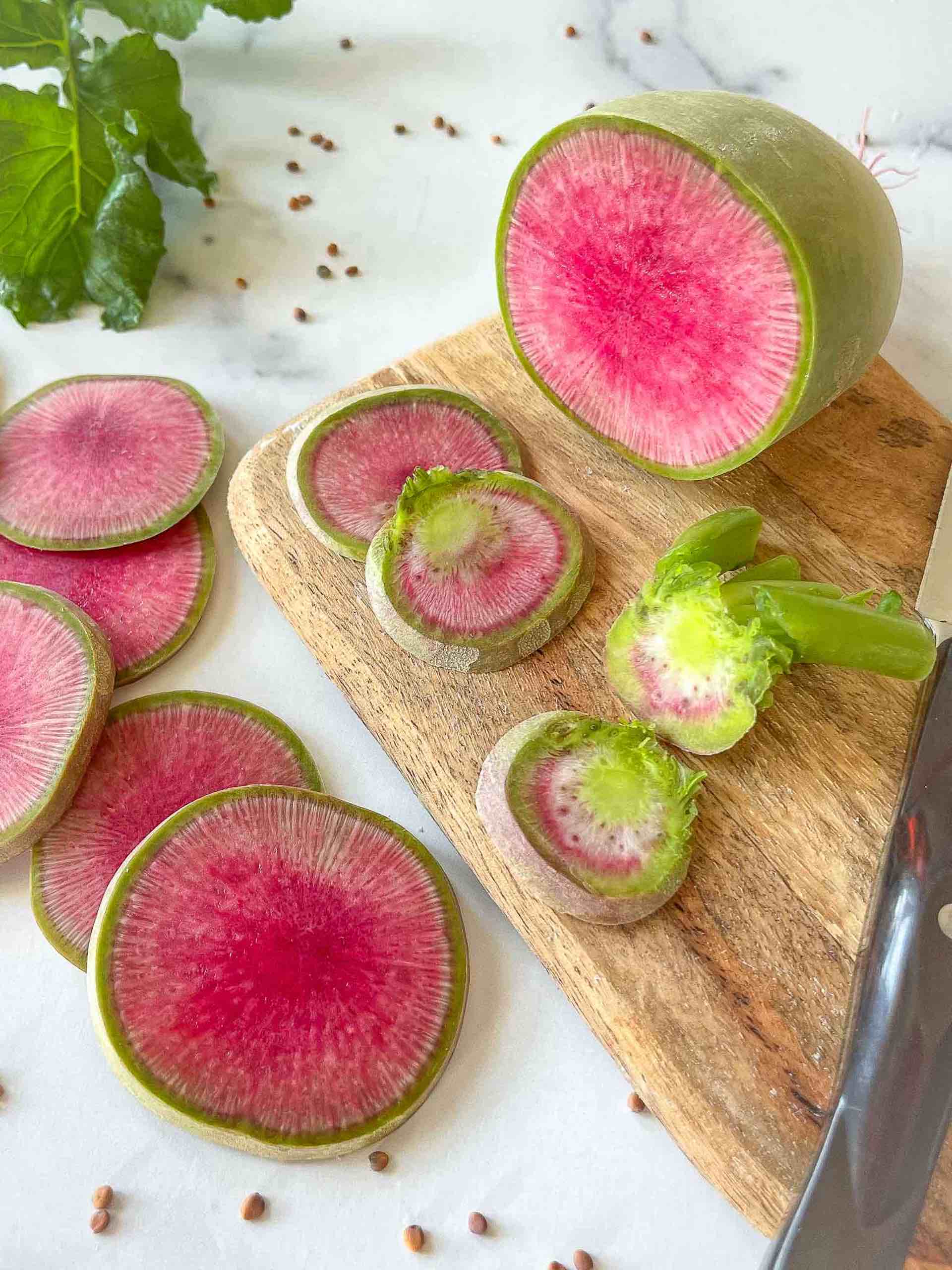
How to Prepare Watermelon Radish
Preparing watermelon radish is quite easy.
-
- Wash the radish – Start by washing the watermelon radish thoroughly under running water. Use a vegetable brush to scrub away any dirt or debris on the outer skin.
- Trim the ends – Using a sharp knife, trim off both ends of the radish to remove any rough or discolored portions.
- Peel the skin (optional) – Watermelon radish skin is edible and contains nutrients, but if you prefer a milder flavor or want to remove any tough or bitter skin, you can peel it using a vegetable peeler. However, if the skin is thin and in good condition, you can leave it on for added texture and color.
- Slice or dice – Decide how you want to cut the watermelon radish based on your recipe or personal preference. You can slice it into rounds for salads, cut it into matchsticks for slaws or stir-fries, or dice it into cubes for pickling or roasting.
- Enjoy raw or cooked – Watermelon radish can be enjoyed raw or cooked, depending on your preference. It adds a vibrant pop of color and a mild peppery flavor to salads, sandwiches, wraps, and appetizer platters. You can also roast or sauté it to bring out its natural sweetness and soften its texture. Watermelon radish is a versatile ingredient that can be used in various dishes to add both visual appeal and taste.
Remember, watermelon radish can stain other ingredients, so be mindful when using it in dishes with light-colored ingredients. It’s best to store prepared watermelon radish in an airtight container in the refrigerator to maintain its freshness. Enjoy experimenting with this unique and beautiful radish in your culinary creations!

Serving Suggestions for Watermelon Radish
Simple to prepare and wonderfully delicious!
-
- Quick Pickled Watermelon Radish– Quick pickled watermelon radish is tangy, crunchy, and delicious. You can have a gorgeous jar of pickled watermelon radish ready within ten minutes!
- Grain Bowls – Watermelon radishes make a perfect additional to any grain bowl.
- In a salad – One of my all-time favorite salads is my Spring Salad w/Watermelon Radish, Fresh Herbs, and Ricotta-Stuffed Pea Pods. Say no more!
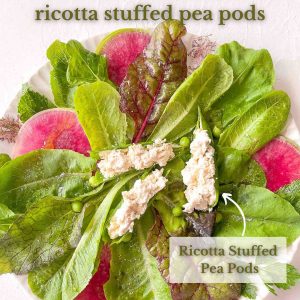
Watermelon Radish, Young Lettuces, Spring Peas, Fresh Herbs, Ricotta-Stuffed Pea Pads
Ingredients
- 1 fresh watermelon radish
- 2 cups tender young lettuces
- 1/2 cup vegan ricotta cheese
- 1/4 cup assorted fresh herbs
- 1/4 cup hulled fresh snap peas
- 3 pea pods
Instructions
- Prepare the watermelon radish – Wash the watermelon radish thoroughly under running water, then use a vegetable brush to scrub away any dirt or debris on the outer skin. Trim off both ends of the radish with a sharp knife to remove any rough or discolored portions. Optionally, you can peel the skin using a vegetable peeler if desired. Leave the skin on for added texture and color if it’s thin and in good condition.
- Prepare the young lettuces and fresh herbs – Wash the young lettuces and fresh herbs under cold water. Then gently pat them dry or use a salad spinner to remove excess moisture. Tear the lettuces into bite-sized pieces and finely chop the fresh herbs.
- Prepare the ricotta-stuffed pea pods– Rinse the pea pods and remove the strings, if any. Mix the ricotta cheese with a pinch of salt and pepper in a small bowl. Gently open the pea pods and stuff them with the ricotta cheese mixture. Set aside
- Prepare the vinaigrette – In a separate bowl, whisk together olive oil, lemon juice, honey, Dijon mustard, salt, and pepper. Adjust the quantities to taste
- Assemble the salad – In a large salad bowl, combine the young lettuces, fresh herbs, and sliced watermelon radish. Drizzle the vinaigrette over the salad and toss gently to coat the ingredients. Place the ricotta-stuffed pea pods on top of the salad
- A.Serve and enjoy – Serve the Watermelon Radish, Young Lettuces, Fresh Herbs, and Ricotta-Stuffed Pea Pods immediately. Garnish with additional fresh herbs if desired. Enjoy this refreshing and vibrant salad as a light meal or a side dish.


0 Comments